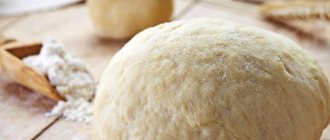Yeast dough is very capricious and therefore requires proper, as well as careful preparation and preservation. Before you start storing yeast dough in the refrigerator after it has been risen, you need to decide after what period of time you intend to use it. If the rules and terms for preserving the product are not followed, it will turn sour and also change its taste, which will negatively affect baked goods.
Where and how to store yeast dough, if there is any left
The product must be stored in the refrigerator and also in the freezer without any consequences, but at the same time observing the required temperature conditions and packaging requirements. This beneficial property of the dough is due to the fact that its base is represented by flour with water or milk and other dairy products. Flour is “not afraid” of temperature changes, and liquid freezes and melts without any problems.
Yeast does not die during freezing, but slows down the fermentation process or even stops it until the temperature of the product rises. Even at low temperatures (not lower than 0°C), they, albeit slowly, continue to ferment. It is precisely because of the last factor that it will not be possible to preserve the dough in the refrigerator for a long time; for this it is better to freeze it.
Storage Features
There are a very large number of varieties of dough, and each of them requires special conditions. In the refrigerator, the raw product is stored at a temperature of 3 to 7 degrees. It is preferable to keep the semi-finished product on a shelf with zero temperature.
The freezer requires preparation for storage. The mass needs to be kneaded well, rolled into a ball, greased with oil or sprinkled with flour. The raw mixture is stored in bags or closed containers. Deep freezing assumes a temperature of -5 to -15 degrees. It is not advisable to store any product in the freezer for longer than 6 months.
Every housewife should have the habit of putting stickers with the date of manufacture on the packaging. This will help determine exactly how long you can store the desired product.
Ready
Sometimes it is convenient to store the dough in the form of semi-finished products.
For this purpose, you need to mold the products, put the filling, and put them in the oven. Bring the product to a semi-prepared state and cool. Wrap each pie in film and freeze.
The shelf life of such semi-finished products is up to 3 months.
Prepared choux pastry products are stored at a temperature of 0 to 6 degrees for about 3 days, and in the freezer for 1 month.
The biscuit is frozen, wrapped in parchment. Before use, the product is heated in the oven.
Cakes for honey cake or Napoleon are covered with foil and kept in the refrigerator for 3 days.
Yeast
The main component of this dough is yeast. This reduces its shelf life, the mass turns sour, becomes sticky, and unsuitable for use. At a temperature of 18-20 degrees, the finished product can be stored for 3 hours.
The semi-finished product is kept in the refrigerator for no more than a day. Before sending it, it must be thoroughly mixed, sprinkled with flour, and placed in a bag or container. It is necessary to take into account that the yeast mass requires oxygen and space. If the semi-finished product spent more than a day at a temperature of 2 - 6 degrees, then the quality of the products made from it will decrease.
8 ways to protect cereals from pests
Ready-made yeast dough can be stored in the freezer longer – from 2 to 3 months. It is important to note that it is best to store fresh product prepared with kefir. The mass must be mixed well and placed in a bag, leaving room for lifting to avoid tears.
Yeast-free
If the semi-finished product is prepared without yeast, then preserving it is much easier.
The mass should be divided into portions, wrapped in a bag or film, and then stored refrigerated for up to 48 hours, or frozen for about 30 days.
Sand
The dough, which is called shortbread, comes in two types: regular and chopped. The latter option must be used immediately after preparation.
Shortbread dough keeps well refrigerated for up to 36 hours, or frozen for up to 3 months. Products made from frozen or chilled semi-finished products have a more crumbly and crispy structure than those from a fresh product.
Puff
Preparing puff pastry requires a lot of effort and time from the housewife. There is a natural desire to prepare such a semi-finished product for future use. Its structure is provided by the presence of fats. To maintain quality characteristics, it is very important to comply with all requirements.
Chilled sheets are suitable for use for 2-3 days.
The shelf life of this product at sub-zero temperatures depends on the ingredients in the composition. If butter was used to prepare the semi-finished product, it can be stored for 30 to 50 days.
Dough containing only vegetable oil or margarine can be kept in the freezer for up to 6 months.
Particular attention should be paid to protecting the product from moisture. For better results, roll the sheet and wrap it in film.
Custard
Since this product does not have a dense structure, it is worth choosing a container with a tight lid to store it. Before placing the mixture in a bowl, it is worth transferring it into a bag. This will better retain moisture.
The container can remain in the refrigerator for up to 3 days. On the first and second days the dough will have good performance; by the third day it will not spoil, but will be stale.
Frozen choux pastry retains its quality for up to 30 days.
Fresh for dumplings, dumplings and noodles
Kneaded unleavened dough in the kitchen quickly becomes unusable. The mass should be rolled into a tight ball, sprinkled with flour, or covered with refined oil and placed in a bag or hermetically sealed container.
A product that is stored at zero temperature can be used for the first three days. On the fourth day it can no longer be cooked.
Frozen dough for dumplings or dumplings retains its quality for up to 180 days.
Dumpling dough can be used to make flatbreads, bread, or fried in a frying pan.
Gingerbread
The technology for preparing gingerbread dough requires infusing the product in the refrigerator for 24 hours. You can store the raw mass in the refrigerator for 20 - 30 days. The frozen mixture can last up to six months.
Since a lot of spices are added to the gingerbread mixture, storage containers must be airtight, otherwise other products will smell of spices.
How to properly store honey in an apartment
Butter
The shelf life of the butter dough is no more than 48 hours, but it is much better to prepare the products on the first day, since the mixture may turn sour.
Frozen product can be stored for no more than 90 days.
Biscuit
The biscuit or charlotte preparation is suitable for use after 6-7 days in the refrigerator, and six months when frozen.
Storage conditions: hermetically sealed container.
On kefir
Batter made with kefir and soda can only be stored in the refrigerator for no longer than 48 hours. At low temperatures it delaminates.
Yeast mass on kefir is suitable for use for up to 2 days at zero temperature, and when frozen for about 3 months.
Honey
If the mixture for making honey cake or gingerbread contains eggs, then it should be kept in a closed container at zero temperature for no more than 24 hours, and at sub-zero temperatures for up to 60 days.
Honey itself is an excellent preservative, and dough for gingerbread or gingerbread, without eggs or milk in the composition, can lie on the refrigerator shelf at zero temperature for up to two weeks, and up to 6 months when frozen. At the same time, do not forget about airtight containers.
Ginger
The basic gingerbread recipe involves adding eggs. This means that such a mixture cannot be stored in the refrigerator for more than a day. Raw ginger in a crushed state quickly becomes unusable.
If the composition does not include eggs or milk, and dry ginger is used instead of fresh root, then the mass is suitable for use for up to 2 weeks.
Frozen product is stored in a closed container for 2 months.
Curd
The dough to which cottage cheese is added is suitable for use for 3 days if it lies on the refrigerator shelf.
If there is a need to store the semi-finished product longer, the mass can be frozen. This way it can be stored for 3 to 6 months. The mixture is rolled into a tight ball and wrapped in cling film. Another storage option involves making dough pieces, freezing them individually, and then putting them in a bag.
Phyllo
Thin sheet dough can be stored in the refrigerator on the coldest shelf for up to 3 days. Frozen semi-finished product without air access is ready for consumption up to 6 months.
Lagmannoe
Prepared lagman noodles can be placed in a bag, blocking the air supply, and kept at zero temperature for up to 3 days. Before use, just pour boiling water over it.
The storage conditions for raw lagman dough are no different from unleavened dough.
For pancakes
Pancake mix can be kept at zero degrees for no longer than 24 hours, since it contains eggs, milk, and other perishable ingredients. In this case, you should periodically open the container with the dough, stirring it to avoid separation.
This product can be stored in the freezer for no more than 60 days in a closed container. It is much more convenient to bake pancakes and freeze them.
For pancakes
Pancakes are a dish that is prepared for breakfast. To save money, raw dough is kneaded for future use. The prepared mixture for pancakes can be safely stored on the refrigerator shelf for 2 days.
The frozen product is suitable for consumption for about two months.
Proper storage of onions in winter
For Napoleon
The best option for storing Napoleon dough is to bake the cakes, wrap them in parchment and keep them on the refrigerator shelf for 3-4 days, and in the freezer for 90 days.
For pizza
Pizza preparations can be stored at zero degrees for 2-3 days, and frozen for up to six months.
The mass is divided into portions and frozen in an airtight container.
For pies
The pie mixture keeps well when frozen. Knead it well, place it in an airtight container, leaving room for growth, stick a sticker with the date on it, and store it for up to 3 months.
The chilled pie mixture can be used for up to two days.
For chebureks
If the pastry dough does not contain eggs or milk, then the container with the mixture can stand on the refrigerator shelf for 2 days. With products that quickly become unusable, you cannot keep the mass for more than a day.
The frozen semi-finished product for pasties can be stored for up to 1 month in a closed container.
For waffles
The mixture from which waffles are baked has foam. It shrinks very quickly, for this reason it is not advisable to keep such a product for a long time. In a closed container, the mass is stored for up to 48 hours.
Rolled out
The dough, which has already been rolled out into a thin layer, can be sprinkled with flour and stored in the refrigerator without access to air.
To store at sub-zero temperatures, each individual tortilla should be frozen individually and dusted with flour.
For modeling (salty)
When making unusual plasticine for modeling, you take flour, salt, and water. This mass keeps well in the refrigerator for two days, or in the freezer for up to 6 months. A mandatory storage condition is sealed containers.
How to store yeast dough in the refrigerator after rising
If you need to pause the process of preparing baked goods or another dish “for tomorrow,” you can put the product in the cold. For storage we use the following methods:
- Saving in a container. Thoroughly knead the remaining finished dough so that excess carbon dioxide “goes away”, roll into balls, sprinkle its surface and container with flour. We put it in a container, which we cover with cling film and make small holes in it so that it can “breathe”. At the same time, we try to use deep containers with a volume of approximately 2 times the volume of the dough, since it will continue to grow.
- Storage in bags. Knead the dough well several times, form a ball and lightly coat with vegetable oil. We put them in large high-density bags, 2 times the size of the ball, remove excess air, tighten them and make small holes.
On a note!
A good option for storing in the refrigerator is unleavened dough, because it does not contain sugar, which accelerates the fermentation process. To preserve the butter, we leave it until the next morning at most, otherwise we freeze it immediately. To prepare pies/buns and other dishes from the product, take it out, knead it well on a surface sprinkled with flour, transfer it to a deep bowl/saucepan and transfer it to a warm place to rise.
How long does yeast dough last in the refrigerator?
The shelf life of yeast dough in the refrigerator depends on the chosen storage method and temperature conditions:
| Storage method | Temperature | Shelf life |
| In container | +5-8°С | Up to 24 hours |
| In the package | +1-3°С | Up to 2 days |
If the permissible storage period is exceeded, the product ferments and sours, does not rise, and when cooked gives the baked dish a strong sour-yeasty smell and an unpleasant taste.
Timing and types
Dear readers! To solve your problem right now, get a free consultation
— contact the lawyer on duty in the online chat on the right or call: +7 (499) 938 6124 — Moscow and region.
+7 (812) 425 6761 — St. Petersburg and region. 8 (800) 350 8362 - Other regions of the Russian Federation You will not need to waste your time and nerves
- an experienced lawyer will solve all your problems!
| Kinds | Deadlines | ||
| Freezer (months) | Refrigerator (days) | Room t (hours) | |
| Yeast (sour) | 2-3 | 1-2 | 1 |
| Yeast-free (fresh) | 6 | 2-3 | 1 |
| Puff | 1-2 | 1-2 | 1 |
| Custard | 1 | 3 | 1 |
| Pelmennoe | 6 | 2-3 | 1 |
| Sand | 2-3 | 2-3 | 3-4 |
| Biscuit | 6 | 3 | 1 |
| For pancakes | 1 | 1 | 2-3 |
| For pizza | 6 | 2-3 | 1 |
| On kefir | 1 | 1 | 2-3 |
| For pancakes | 1 | 1 | 2-3 |
Is it possible to store yeast dough in the freezer?
For long-term storage we use freezing. We freeze fresh, only kneaded product, do not put in the freezer something that has been in the cold for some time, otherwise it will not be able to rise after defrosting.
Knead the dough well, divide into small portions, roll in flour or coat with butter and wrap in a sealed bag. To save, you can also take special ziplock bags or cling film. When storing in the latter, there is no need to lubricate the product with oil. To make it freeze faster, you can roll it out first. Dividing the dough into small portions is necessary because it cannot be re-frozen.
Advice!
We recommend that you indicate the date of freezing and the type of dough prepared on the bags so that you can use it on time.
Freezing and storage of semi-finished products is also possible. To do this, place the prepared buns on a baking sheet and place in the oven for a few minutes. As soon as they rise a little, take them out, cool them, wrap the baking sheet in cling film and put them in the freezer. If necessary, take it out, defrost and bake until fully cooked.
Recommendations
A few simple storage rules that modern housewives will need:
- The dough is susceptible to odors. Therefore, it needs to be placed on an empty shelf. It is better to move other products further away.
- The yeast mixture should not be left overnight, even if the room is cool. It may turn sour until the morning.
- If you get a large amount of mass, it is better to divide it into several parts to maintain the temperature regime.
- To avoid missing the expiration date, it is recommended to leave a note with the freezing date.
Even with proper storage, the yeast base can deteriorate.
The main signs of a poor quality product:
- the presence of an unpleasant and sour odor;
- texture change;
- the surface becomes sticky or slippery.
If after defrosting at least one of the above symptoms is present, the finished product must be discarded immediately.
Shelf life of yeast dough in the freezer
You can store the product in the freezer for 2-3 months. In this case, the temperature must be maintained within -15-18°C. A longer storage period will lead to freezing of the product, due to which it will lose its taste and will not rise after defrosting.
The product purchased in the store is stored longer - 4-5 months, due to the presence of preservatives in the composition. Its storage temperature is -18°C and below.
Useful tips
Long shelf life dough
Certain types of dough can sit on the refrigerator or freezer shelf for a very long time. This applies to unleavened, flaky, yeast-free, custard, honey, ginger and gingerbread products. A prerequisite for such a semi-finished product is the absence of perishable products in the composition.
When frozen, such a mixture can retain its qualities for six months.
Defrosting rules
The best options for thawing dough are in the refrigerator or at room temperature. After 2-3 hours, put it on the surface, knead, put in a bowl, cover with a towel and leave in a warm place to rise.
It is also possible to use faster methods:
- on the stove/battery/heater and other heating devices. Place the dough in the pan, cover with a lid and place the pan on or near a heat source;
- in warm water. Without removing the product from the bag, immerse it in warm water. We periodically change it or heat it up;
- in the microwave. Set the “Defrost” mode and select the required time. We do not recommend using this option, since there is a high risk of the product overheating or chapping.
According to GOST
A number of standards apply:
- GOST 31806-2012 “Semi-finished bakery products, frozen and chilled. General technical conditions" contains requirements for the quality and organoleptic properties of semi-finished bakery products.
- TU 10.71.11-001-38676869-2017 “Chilled pizza dough.”
- TU 9115-001-03424982-2016 “Yeast, yeast-free, puff pastry.”
- TU 9115-007-42842345-2015 “Frozen and chilled dough”.
- TU 9195-001-30455011-2009 “Pancake dough”.
- SanPiN 2.3.2.1078-01 “Hygienic requirements for the safety and nutritional value of products” indicates what the content, composition should be, and lists the regulatory authorities.
Cold dough recipe
The dough prepared according to this recipe is not “afraid” of drafts and fits well even in the refrigerator. And baked goods prepared on its basis are very tasty and aromatic. Cooking with:
- dry instant yeast – 22 g;
- flour – 10 tbsp;
- eggs – 4 pcs.;
- butter – 400 g;
- milk – 2 tbsp.;
- sugar – 1 tbsp. for sweet pastries, 2 tbsp. for savory;
- salt – 1 tsp.
How to cook:
Heat the milk a little until it is warm, pour it into a bowl and mix with the eggs. Melt the butter, cool slightly until warm and add to the milk-egg mixture. Add sugar and salt, mix well and add yeast. Sift the flour, mix it into the mixture in parts, knead the dough thoroughly. Transfer it to a bag and put it in the refrigerator for 2 hours.
And the second video recipe on how to prepare yeast dough using a super method.











